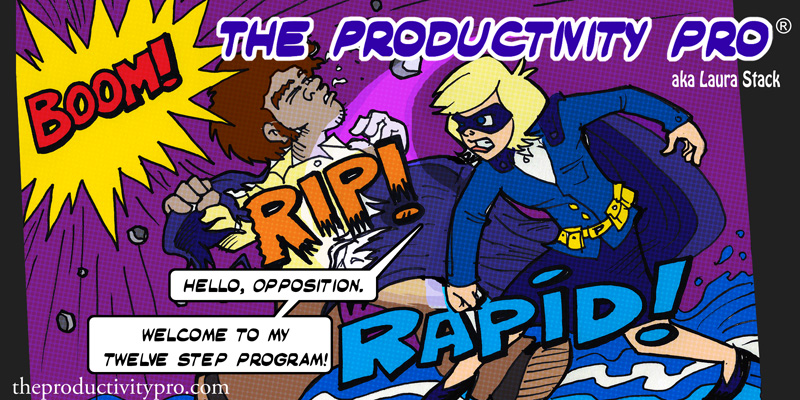
“When it is obvious that a goal cannot be reached, do not adjust the goal; adjust your course.”—attributed to Confucius, ancient Chinese philosopher.
When available, I enjoy watching the TV screens on the seat back in front of me, showing the plane’s current location and route, including the dozen subtle adjustments the pilot made along the way. The road to achieving any goal is like that airplane’s flight. Activity-goal alignment requires you to constantly monitor your goals and repeatedly make adjustments to your course.
Of course, this assumes you know what your goals are.
Hitting your work goals isn’t necessarily a complex process, but it does break down into a surprising number of steps you need to take into account before you can make any real headway. Just jumping in and instinctively swimming can work, but it’s best to consider this 12-Step Program on the way to the finish line (BOOM RIP RAPID):
1. Big Reasons
2. Objectives
3. Output
4. Measurement
5. Restraints
6. Ideal Situation
7. Practical Reality
8. Resources
9. Analysis
10. Plan
11. Individual Tactics
12. Daily Activity
Let’s take a closer look at each:
1. Big Reasons. What are your big reasons for taking on the goal? Write them down and keep them in mind, checking in on them regularly. The WHY makes the HOW easier.
2. Objectives represent milestones on your route—specific targets you want to hit. If you want to become the youngest CEO of a major corporation, you’ll first need to get an MBA or other advanced degree, land a great position right out of college, and then start climbing the ladder.
3. Output is your tangible short-term product: for example, a tightly run team, a certain number of speaking engagements, cases closed per month, a quota of program modules, or a series of white papers defining your product’s specs.
4. Measurement quantifies your production. How many program modules have you produced this week? How much money has the business made this month? Have you hit your numbers in sales goals? Production must be easily counted and unmistakable, whether you’re keeping score with dollars or percentage of market share. How will you know if you’re willing against your output above?
5. Restraints. What physical, political, or processual restraints might slow your output? Are there legal, moral, or ethical limits to consider, or is the only limit data or cash on hand? Do you need partners to help you with social media? Do you need to create content to solidify your brand?
6. Ideal Situation. What you want to accomplish: the best of all possible worlds in terms of production speed and results. This is your high number.
7. Practical Reality. What you actually have, based on the restraints you have to work within. This is your realistic goal.
8. Resources. What goods and services can you tap? What else can you leverage if certain conditions are met? Include all capital, materials, equipment, machinery, time, human talent, and energy you can put into the effort. Can you hire someone on www.upwork.com to help out? Can you lean on a support department internally to help you? Can you buy a list of prospects? Can you get another department on board to contribute?
9. Analysis. What do you want to accomplish, and how can you do it based on all the previous steps? Once you’ve plugged everything into the equation, you may find you need to revise your initial estimates based on new limitations.
10. Plan. Once you’ve analyzed the situation and know what you have to work with, plan on how to accomplish your goal. Lay out your overall strategy, and define the tactics needed to accomplish that strategy.
11. Individual Tactics. These are the things you do to get there. If your organization tells you to start a satellite office in Seattle, your tactics for doing so may include the following: (1) Do market research; (2) Secure funding; (3) Scout locations; (4) Rent office space; (5) Buy office furniture; and so on. Go with the flow, changing tactics as necessary.
12. Daily Activity includes daily tasks you have to undertake to reach your goal. Many will be standard to-do list items specific to that goal—normal maintenance and incremental items that move you forward. Your to-do list will likely include daily activities toward a number of goals, large and small.
Boom! Rip! Rapid!
BOOM RIP RAPID is intended a mnemonic to help you remember the steps required to secure a goal—though I’ll admit it’s a bit more complex than “Every Good Boy Does Fine” or “King Philip Came Over for Green Stamps.” Once internalized, it will help you keep your goal on track, from the first tentative considerations to the final wrap-up. Given a little study, it will become second nature… even if the acronym does resemble the sound effects from a Batman comic book.
© 2016 Laura Stack. Laura Stack, MBA, CSP, CPAE is an award-winning keynote speaker, bestselling author, and noted authority on employee and team productivity. She is the president of The Productivity Pro, Inc., a company dedicated to helping leaders increase workplace performance in high-stress environments. Stack has authored seven books, including Doing the Right Things Right: How the Effective Executive Spends Time (January 18, 2016). She is a past president of the National Speakers Association, and in 2015 was inducted into its exclusive Speaker Hall of Fame (with fewer than 175 members worldwide). Stack’s clients include Cisco Systems, Wal-Mart, and Bank of America, and she has been featured on the CBS Early Show and CNN, and in the New York Times. To have Laura Stack speak at your next event, call 303-471-7401 or visit her website.



Great post Laura, many thanks for sharing it with me. – Barry.
Thanks Barry!